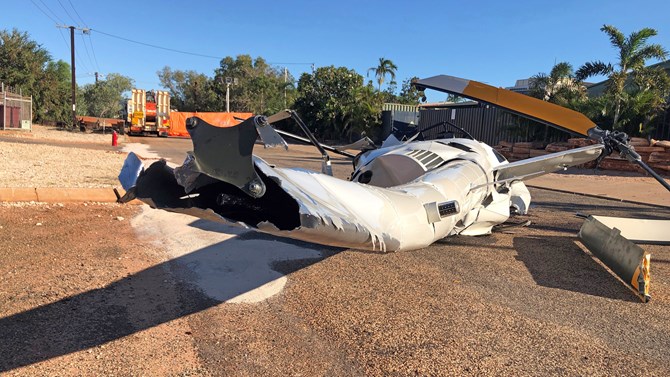Fatal Accident Investigation: Downed Robinson R44 Helicopter, Western Australia

The Australian Transport Safety Bureau has released an update from its ongoing investigation into the fatal accident involving a Robinson R44 helicopter at Broome, Western Australia, on July 4.
“Based on CCTV footage and examination of the wreckage, the Australian Transport Safety Bureau (ATSB) investigators have been able to determine that the helicopter’s tail rotor gearbox, tail rotor and tail assembly separated from the helicopter soon after take-off,” said ATSB Chief Commissioner Greg Hood.
Following the in-flight separation of the tail, the helicopter then fell to the ground, out of control.
“We appreciate that this information may be confronting to the families and friends affected by this tragic accident, and it is for this reason that the ATSB will not be releasing the CCTV footage due to its potentially distressing nature,” Mr. Hood said.
Since arriving on site in Broome on Monday, transport safety investigators have conducted a detailed inspection of the helicopter wreckage, and are arranging to transport relevant components back to the ATSB’s technical facilities in Canberra for further examination.
Investigators have also interviewed a pilot who flew the accident aircraft on July 2
The pilot reported feeling unusual vibrations through the tail rotor pedals. The pilot of the accident flight also conducted a short flight in the helicopter and confirmed the unusual vibrations.
Maintenance personnel subsequently conducted a dynamic tail rotor balance on the day before the accident.
“At this stage the reasons for the in-flight breakup, and the significance of the reported vibrations through the tail rotor pedals, are not known, and the ATSB will provide further advice when relevant information is available,” Mr. Hood said.
“While the investigation is ongoing, the ATSB urges any R44 pilot that experiences unusual vibrations through the tail rotor pedals to land as soon as possible.”
As the investigation progresses, the ATSB will continue to liaise with the Civil Aviation Safety Authority, the US National Transportation Safety Board, and the Robinson Helicopter Company.
The Robinson R44 was certified in December 1992 and the model involved in this accident, the R44 Raven I, was introduced in January 2000. There are currently 558 R44s on the Australian civil aircraft register.
Key points: ATSB
- Helicopter’s tail assembly separated in-flight.
- Cause of the separation is currently unknown.
- R44 pilots who experience unusual vibrations through the tail rotor pedals are urged to land as soon as possible.
Read the update: AO-2020-033: In-flight breakup involving Robinson R44 Raven I, VH-NBY, 2 km north of Broome Airport, Western Australia, on 4 July 2020.
Founded in 1988, the TapRooT® Root Cause Analysis System solves hurdles every investigator faces
TapRooT® Root Cause Analysis Training System takes an investigator beyond his or her knowledge to think outside the box. Backed with extensive research in human performance, incident investigation, and root cause analysis, TapRooT® is a global leader in improved investigation effectiveness and productivity, stopping finger-pointing and blame, improving equipment reliability, and fixing operating problems.

System Improvements, the creator of the TapRooT® System, has a team of investigators and instructors with years of extensive training ready to offer assistance worldwide.
TapRooT® Root Cause Analysis Training courses are taught all over the world
If you are interested in learning how to stop repeat incidents, find a 2-Day or 5-Day course; or view the complete selection of TapRooT® courses. We are available to train you and your staff on-site at your workplace; Contact us to discuss your needs. You may also call us at 865.539.2139 to discuss any questions you may have.
Keep in touch to improve your problem-solving skills
We’re continually training, helping you improve your professional root cause analysis skills. Stay current with your TapRooT® Root Cause Analysis skills and training through:
- Following our blog;
- Free newsletters;
- Tuning in to TapRooT® TV Video Sessions or our podcasts;
- Connecting with us on Facebook, Twitter, Instagram, Pinterest, LinkedIn, and YouTube;
- And our annual Global TapRooT® Summit.



